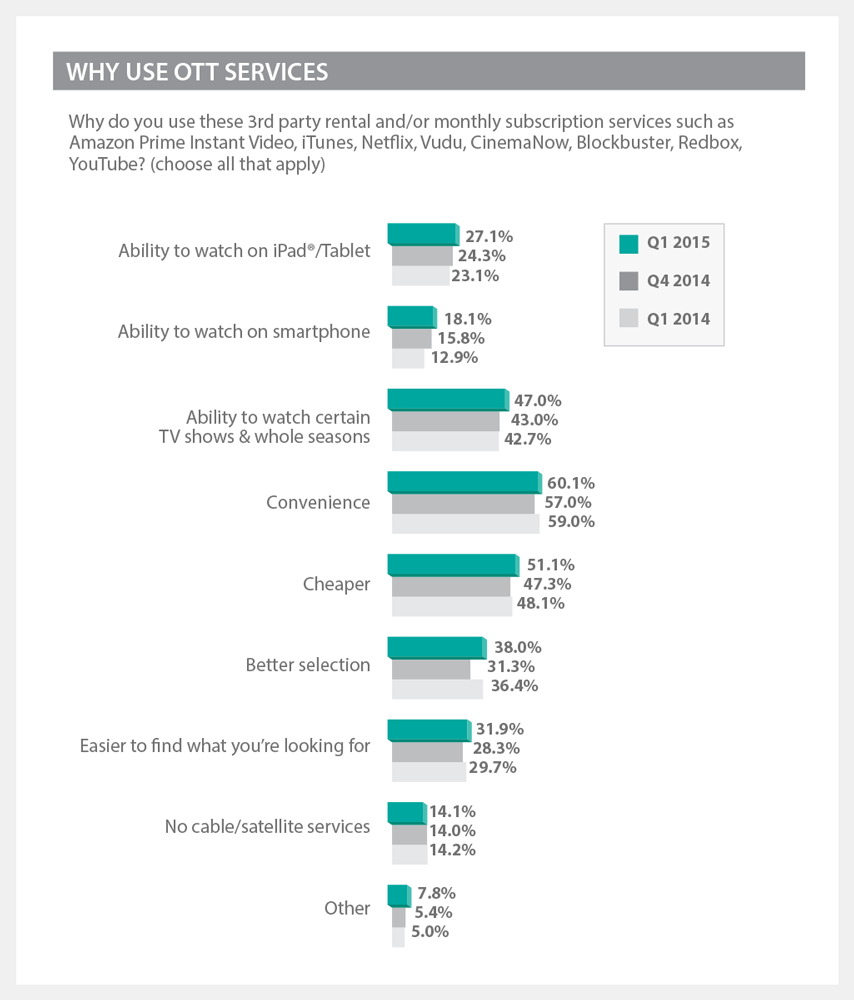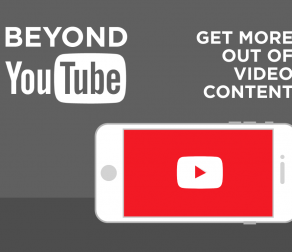TV Everywhere…Literally
If you haven’t noticed, the way Americans consume TV and video content is changing wildly. While some of us are upgrading our internet broadband connections to take advantage of every level of resolution offered by a 4K/UHD TV, the younger among us would argue that Wi-Fi and a minimal 4’’ iPod screen are all one needs to enjoy TV (they’re all we need to watch our Netflix shows, after all). The situation is complicated, involving new and legacy programming models, the expectations and habits of different generations, hardware that never existed before…the list goes on.
First, there are the content providers:
- Traditional cable and network TV
- Subscription services like Netflix, Hulu and Amazon Prime
- TV Everywhere services like HBO Go and CW Seed
- User-generated content like YouTube, Periscope and Meerkat
Then, the devices:
- TV
- Desktop / laptop
- Tablet
- Smartphone
- Apple TV, Roku, Amazon Fire, Chromecast…
With all of these options available, Americans are beginning to divide into three camps:
- Cord nevers have never subscribed to a multichannel video service like a traditional cable channel lineup and have only consumed video content via subscription services, TV Everywhere or user generated content
- Cord cutters subscribed to cable TV at one time, but have since cancelled
- Cord shavers have one foot in both worlds, subscribing to a reduced number of traditional cable channels and binge-friendly services like Netflix and Hulu
 According to a recent study by Digitalsmiths, the number of cord cutters in North America is growing. In 2014, 8.2% of former pay cable TV subscribers cut the cord—a 1.3% increase over the previous year. At the same time, awareness of and loyalty to cable alternatives is on the rise. The Digitalsmiths study also found that 54.4% of respondents used monthly subscription services like Netflix and Hulu, and they were willing to pay more for these subscriptions than they had been in previous years.
According to a recent study by Digitalsmiths, the number of cord cutters in North America is growing. In 2014, 8.2% of former pay cable TV subscribers cut the cord—a 1.3% increase over the previous year. At the same time, awareness of and loyalty to cable alternatives is on the rise. The Digitalsmiths study also found that 54.4% of respondents used monthly subscription services like Netflix and Hulu, and they were willing to pay more for these subscriptions than they had been in previous years.
So what’s driving this trend away from traditional TV? The study looked into that, too. Unsurprisingly, cost, customer service and content viewing flexibility were top influencing factors.
Engagement Opportunities for Media & Entertainment
For media and entertainment companies, this is definitely a case of “when one door closes, another one opens.” Viewers might be migrating away from traditional media—but in doing so they are creating a whole new realm of engagement opportunity for brands.
TV Everywhere is a great example of that: as viewers increasingly consume content on handheld devices, TV networks are meeting them there, offering subscription-based programming to be consumed anywhere (under controlled network conditions), from computers to tablets and smartphones to streaming boxes. The projected ad revenue from TV Everywhere and other “over-the-top” (OTT) services is on the order of $40 billion by the end of 2020.
To understand your audience, you need to understand their digital habitat. Here’s some insight into what viewers are thinking about as they deliberate which camp to join (cord nevers, cord cutters or cord shavers):
- There isn’t a perfect alternative. You may need to combine several services to guarantee access to your favorite show.
- Are streaming alternatives really cheaper than cable? Monthly subscriptions are cheaper for sure, but after combining your services a la carte, you may spend just as much (or more) as you did on your old cable bill.
- Oh, live events! Live events are not easily transmitted via services like Netflix and Hulu, so your only options for viewing your favorite games live may still be on a local / cable channel or at a sports bar.
- Do you have the power? You may need to upgrade your bandwidth to ensure that your household has access to high-def content.
As complex as the situation is, we may need to add a fourth consumer type here: the smart viewer. These folks know their options and have chosen the best one to meet their lifestyle needs and preferences. The availability of content, providers and mobile technology is forcing this change—now it’s up to brands to keep evolving in ways that clearly benefit their viewers.











The term “cord-cutter” has – unfortunately – become ensconced in our vernacular. If there were a wholesale shift from wired distribution to wireless, that would be cord-cutting. But that’s not what’s happening.
Most “cord-cutters” continue to subscriber to a broadband provider (primarily cable or phone) and have a “cord” delivering to content to their home.
What is occurring… consumers are moving from “scheduled” content consumption to “on-demand” consumption of direct-to-consumer content. Technically this could have occurred years ago. What prevented direct-to-consumer content consumption (until very recently) were agreements between content creators and cable operators (gate-keepers). We can thank Netflix for busting the gate : )
Of course, cord cutting options are cheaper than cable unless you’re foolish enough to sign up for every streaming service available. But here’s the thing: when I was still paying for my Comcast cable bundle, I had already subscribed to Hulu and Netflix because I could rarely find anything worth watching on cable. So when I cut the cord in June, my only new cost was Sling TV at $20 a month. Total monthly savings after switching internet services: $95… [I would love to hear from other real-life cord-cutters about their experiences.]
I would say that the “smart viewer” is probably also an “early adopter” and has either been a “cord cutter” or “cord shaver” (Sorry for all the quotes). These users are learning from their experiences and adapting quickly. Similar to how “our” parents stayed in one job their whole lives, people are changing jobs every 2-3 years to get ahead. Consumer are making changes quickly to stay with the pace of innovation. Linux users/Torrenters/P2P/techies were the first to cut the cord as they were more savvy on how to acquire content before it was readily available to stream. Now that streaming is almost ubiquitous, a lot portion of the population is some version of the “cord cutter” but there are as mentioned by combining different products people can gain the best possible outcome; the best content at the cheapest prices. I’m starting to see an early shift of the general consumer market move towards a traditionally more techie approach. With BitTorrent.com becoming more easy to use and new(er) apps like plex.tv and getyounity.com helping to stream your own content (stuff that lives on your own computers/drives – user generated and not) from where content is store to the places you want to watch it (TV’s and mobile devices), those general consumers are able to jump on the nearly free bandwagon that was previously reserved for the more technically inclined.